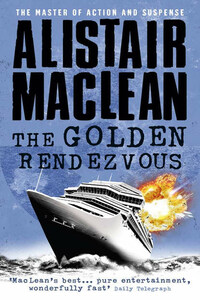An overhead broadcaster on the bridge of the frigate Ariadne crackled into life, a bell rang twice and then O’Rourke’s voice came through, calm, modulated, precise and unmistakably Irish. O’Rourke was commonly referred to as the weatherman, which he wasn’t at all.
‘Just picked up an odd-looking customer. Forty miles out, bearing 222.’
Talbot pressed the reply button. ‘The skies above us, Chief, are hotching with odd-looking customers. At least six airlines criss-cross this patch of the Aegean. NATO planes, as you know better than all of us, are all around us. And those pesky fighter-bombers and fighters from the pesky Sixth Fleet bloweth where the wind listeth. Me, I think they’re lost half the time.’
‘Ah! But this is a very odd odd-looking lad.’ O’Rourke’s voice was unruffled as ever, unmoved by the less than flattering reference to the Sixth Fleet, from which he was on temporary loan. ‘No trans-Aegean airline uses the flight path this plane is on. There are no NATO planes in this particular sector on my display screen. And the Americans would have let us know. A very courteous lot, Captain. The Sixth Fleet, I mean.’
‘True, true.’ The Sixth Fleet, Talbot was aware, would have informed him of the presence of any of their aircraft in his vicinity, not from courtesy but because regulations demanded it, a fact of which O’Rourke was as well aware as he was. O’Rourke was a doughty defender of his home fleet. ‘That all you have on this lad?’
‘No. Two things. This plane is on a due southwest to north-east course. I have no record, no information of any plane that could be following this course. Secondly, I’m pretty sure it’s a big plane. We should see in about four minutes—his course is on a direct intersection with ours.’
‘The size is important, Chief? Lots of big planes around.’
‘Not at 43,000 feet, sir, which is what this one is. Only a Concorde does that and we know there are no Concordes about. Military job, I would guess.’
‘Of unknown origin. A bandit? Could be. Keep an eye on him.’ Talbot looked around and caught the eye of his second-in-command, Lieutenant-Commander Van Gelder. Van Gelder was short, very broad, deeply tanned, flaxen-haired and seemed to find life a source of constant amusement. He was smiling now as he approached the captain.
‘Consider it done, sir. The spy-glass and a photo for your family album?’
‘That’s it. Thank you.’ The Ariadne carried an immense and, to the uninitiated, quite bewildering variety of looking and listening instruments that may well have been unmatched by any naval ship afloat. Among those instruments were what Van Gelder had referred to as the spy-glass. This was a combined telescope and camera, invented and built by the French, of the type used by spy satellites in orbit and which was capable, under ideal atmospheric circumstances, of locating and photographing a white plate from an altitude of 250 miles. The focal length of the telescope was almost infinitely adjustable: in this case Van Gelder would probably use a one in a hundred resolution, which would have the optical effect of bringing the intruder—if intruder it was—to an apparent altitude of four hundred feet. In the cloudless July skies of the Cyclades this presented no problem at all.
Van Gelder had just left the bridge when another loudspeaker came to life, the repeated double buzzer identifying it as the radio-room. The helmsman, Leading Seaman Harrison, leaned forward and made the appropriate switch.
‘I have an SOS. I think—repeat think—vessel’s position is just south of Thera. All I have. Very garbled, certainly not a trained operator. Just keeps repeating “Mayday, Mayday, Mayday”.’ Myers, the radio operator on duty, sounded annoyed: every radio operator, the tone of his voice said, should be as expert and efficient as he was. ‘Wait a minute, though.’ There was a pause, then Myers came on again. ‘Sinking, he says. Four times he said he was sinking.’
Talbot said: ‘That all?’
‘That’s all, sir. He’s gone off the air.’
‘Well, just keep listening on the distress frequency, Harrison, 090 or near enough. Can’t be more than ten, twelve miles away.’ He reached for the engine control and turned it up to full power. The Ariadne, in the modern fashion, had dual engine-room and bridge controls. The engineroom had customarily only one rating, a leading stoker, on watch, and this only because custom dictated it, not because necessity demanded it. The lone watchman might, just possibly, be wandering around with an oil-can in hand but more probably was immersed in one of the lurid magazines with which what was called the engineroom library was so liberally stocked. The Ariadne’s chief engineer, Lieutenant McCafferty, rarely ventured near his own domain. A firstclass engineer, McCafferty claimed he was allergic to diesel fumes and treated with a knowing disdain the frequently repeated observation that, because of the engine-room’s highly efficient extractor fans, it was virtually impossible for anyone to detect the smell of diesel. He was to be found that afternoon, as he was most afternoons, seated in a deckchair aft and immersed in his favourite form of relaxation, the reading of detective novels heavily laced with romance of the more dubious kind.














